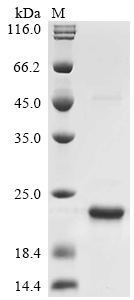Recombinant Rickettsia typhi 17 kDa surface antigen (omp)
CAT:
399-CSB-EP332866RNE-01
Size:
20 µg
Price:
Ask
- Availability: 24/48H Stock Items & 2 to 6 Weeks non Stock Items.
- Dry Ice Shipment: No




Recombinant Rickettsia typhi 17 kDa surface antigen (omp)
- CAS Number: 9000-83-3
- Gene Name: omp
- UniProt: P22882
- Expression Region: 20-159aa
- Organism: Rickettsia typhi (strain ATCC VR-144 / Wilmington)
- Target Sequence: CNGPGGMNKQGTGTLLGGAGGALLGSQFGHGKGQLVGVGVGALLGAVLGGQIGASMDEQDRKLLELTSQRALESAPSGSNIEWRNPDNGNHGYVTPNKTYRNSTGQYCREYTQTVVIGGKQQTTYGNACRQPDGQWQVAN
- Tag: N-terminal 10xHis-tagged and C-terminal Myc-tagged
- Source: E.coli
- Field of Research: Others
- Assay Type: In Stock Protein
- Relevance: Membrane-bound mucin, a family of highly glycosylated proteins that constitute the major component of the mucus, the slimy and viscous secretion covering epithelial surfaces. These glycoproteins play important roles in the protection of the epithelium and are implicated in epithelial renewal and differentiation. Regulates cellular behavior through both anti-adhesive effects on cell-cell and cell-extracellular matrix interactions and its ability to act as an intramembrane ligand for ERBB2. Plays an important role in proliferation and differentiation of epithelial cells by inducing specific phosphorylation of ERBB2. In polarized epithelial cells, segregates ERBB2 and other ERBB receptors and prevents ERBB2 from acting as a coreceptor. The interaction with ERBB2 leads to enhanced expression of CDKN1B. The formation of a MUC4-ERBB2-ERBB3-NRG1 complex leads to down-regulation of CDKN1B, resulting in repression of apoptosis and stimulation of proliferation. Its ability to promote tumor growth may be mainly due to repression of apoptosis as opposed to proliferation.
- Purity: Greater than 90% as determined by SDS-PAGE.
- Activity: Not Test
- Length: Full Length of Mature Protein
- Form: Liquid or Lyophilized powder
- Buffer: If the delivery form is liquid, the default storage buffer is Tris/PBS-based buffer, 5%-50% glycerol. If the delivery form is lyophilized powder, the buffer before lyophilization is Tris/PBS-based buffer, 6% Trehalose, pH 8.0.
- Reconstitution: We recommend that this vial be briefly centrifuged prior to opening to bring the contents to the bottom. Please reconstitute protein in deionized sterile water to a concentration of 0.1-1.0 mg/mL.We recommend to add 5-50% of glycerol (final concentration) and aliquot for long-term storage at -20℃/-80℃. Our default final concentration of glycerol is 50%. Customers could use it as reference.
- Molecular Weight: 22.0 kDa
- References & Citations: "Functional annotation of a full-length mouse cDNA collection." Kawai J., Shinagawa A., Shibata K., Yoshino M., Itoh M., IshII Y., Arakawa T., Hara A., Fukunishi Y., Konno H., Adachi J., Fukuda S., Aizawa K., Izawa M., Nishi K., Kiyosawa H., Kondo S., Yamanaka I. Hayashizaki Y. Nature 409:685-690 (2001)
- Storage Conditions: The shelf life is related to many factors, storage state, buffer ingredients, storage temperature and the stability of the protein itself. Generally, the shelf life of liquid form is 6 months at -20℃/-80℃. The shelf life of lyophilized form is 12 months at -20℃/-80℃.
